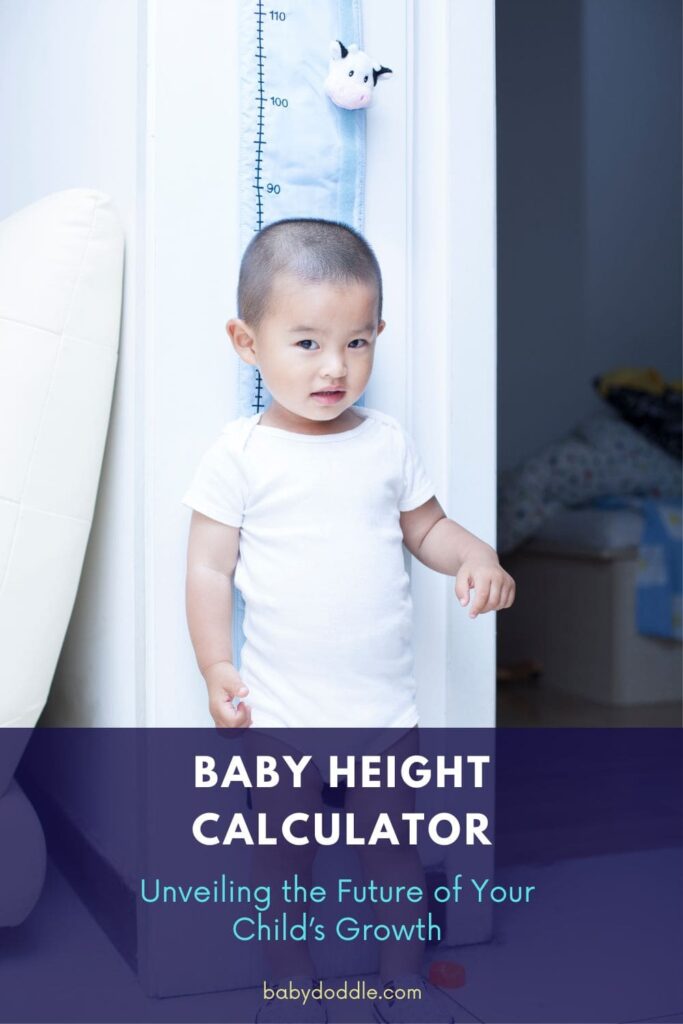Want to get an idea of how tall your child will end up being as an adult? Our baby height calculator provides a useful prediction based on key research.
Based on research by:
- Khamis HJ, Roche AF. Predicting adult stature without using skeletal age: the Khamis-Roche method.; Pediatrics; October 1994
- Wright CM, Cheetham TD. The strengths and limitations of parental heights as a predictor of attained height.; Archives of Disease in Childhood; September 1999
- Silventoinen K, Kaprio J & Lahelma E. Genetic and Environmental Contributions to the Association Between Body Height and Educational Attainment: A Study of Adult Finnish Twins.; Behavior Genetics volume; November 2000
As a parent,Have you ever wondered just how tall your child will end up being as an adult? Whether you’re simply curious or want to know for planning purposes, a baby height calculator can provide a prediction to unveil the future of your child’s growth.
There are a couple different methods parents can use to calculate their child’s eventual height. While not 100% accurate, these baby height calculator provide a useful estimate based on factors like genetics and the parents’ heights. Read on to learn all about predicting your child’s future height and growth.
Remember that Our Baby Height Calculator is not a doctor. If you believe your child is too short or too tall, please consult a pediatrician. While predictions are not exact, this tool provides useful guidance on the future of your child’s growth.
Why Predict Your Child’s Height?
Parents have several reasons for wanting to predict their son or daughter’s adult height. Here are some of the main ones:
- Satisfy Curiosity – It’s only natural to be curious about how tall your child will end up. Estimating their future height can give you a general idea.
- Plan for the Future – Knowing your child’s approximate adult height can help when planning for future needs like clothes, shoes, furniture, etc.
- Monitor Growth – Tracking height predictions from year to year helps monitor whether your child’s growth seems on target or lagging.
Of course, a height prediction is not an exact science and should be seen as a general guideline. But having an estimate in mind can be useful for parents as they watch their child grow.
The Genetics Behind Height
What determines how tall a child will ultimately grow to be? Genetics play a key role. Researchers have found that height is largely an inherited trait, with 60-80% attributed to a person’s genetic makeup. This is known as heritability.
Let’s use an example to understand heritability a bit better. Suppose a father is 6 feet (183 cm) tall, which is 5 cm taller than the average height for white males of 178 cm. If height is 80% heritable, that means 4 cm of the extra height (80% of 5 cm) is likely due to genetics. The remaining 1 cm (20% of 5 cm) can be attributed to non-genetic factors like nutrition.
Studies show heritability percentages for height tend to be around 80% for men and 75% for women. But this can vary substantially between ethnic populations, likely due to differences in environment, nutrition, lifestyles, and combination of genes.
In Asian and African populations, height heritability has been found to be lower at around 65%. This emphasizes that while genetics play a key role, environmental factors like nutrition still have a significant influence on height, estimated to account for 20-40% of the variation between individuals.
Calculating Your Child’s Height
Now let’s discuss some methods parents can use to calculate their child’s predicted adult height.
| Predictor | What’s Needed | Age Range | Accuracy |
|---|---|---|---|
| Khamis-Roche | Child height/weight, parental heights | Over age 4 | Within 2 inches |
| Mid-parental Height | Parental heights | Any age | Within 4 inches |
Khamis-Roche Method
This method provides a fairly accurate height prediction for children over the age of 4. It uses the child’s current height and weight along with the heights of both parents.
Developed in 1994, the Khamis-Roche formula has a margin of error of only 2.1 inches for boys and 1.7 inches for girls. That makes it one of the more reliable child height calculators available without using X-rays to determine bone or skeletal age.
Here is the formula:
Boy’s Adult Height = 39.89 + (0.8 * (Father’s Height + Mother’s Height)/2) – (0.16 * Current Height) + (2.1 * Current Weight)
Girl’s Adult Height = 36.48 + (0.86 * (Father’s Height + Mother’s Height)/2) – (0.142 * Current Height) + (1.17 * Current Weight)
Mid-Parental Height Formula
For kids under 4 or for a quick estimate, the mid-parental height formula provides a simple calculation based on the parents’ heights alone.
Here’s how it works:
- Calculate the mid-parental height: (Mom’s height + Dad’s height) / 2
- For a boy, add 2.5 inches to the mid-parental height
- For a girl, subtract 2.5 inches from the mid-parental height
The margin of error is about 4 inches either way using this formula. So it provides a ballpark estimate but is not as accurate as the Khamis-Roche method.
Limitations : While the above formulas are useful, it is important to note some limitations when predicting a child’s height:
- Formulas are based on averages, so the child may end up substantially taller or shorter.
- Khamis-Roche formula was developed studying Caucasian children, so may be less accurate for other ethnicities.
- Does not account for very unusual growth patterns or health conditions affecting development.
- Can’t predict late growth spurts or environmental impact on final height.
So while handy, height calculators should be seen as a guide not a guarantee of exactly how tall a child will become. Monitoring growth charts over time provides clues about whether projections are on track.
Other Factors Affecting Growth Genetics and parental height provide a strong indicator, but other factors influence a child’s height development as well.
Nutrition – A nutrient-rich diet fuels growth. Children who are overweight but stay active also tend to be taller.
Health Conditions – Chronic illness, arthritis, celiac disease and other conditions may impair development.
Hormones – Growth hormone deficiency or thyroid disorders can affect growth.
Medications – Certain prescription drugs impact hormones and growth rates.
Genetic Conditions – Some chromosomal conditions like Marfan syndrome boost height, while others like Down syndrome reduce it.
Environmental factors are estimated to account for 20-40% of height variation between kids. So while genes are key, nutrition and health play supporting roles in reaching full growth potential.

Understanding Bone Age to Predict Growth
Bone age assessment is a key way doctors evaluate skeletal maturity in growing children. This important diagnostic tool can reveal potential growth problems or determine when puberty may begin.
Determining Bone Age
A bone age study involves taking a single x-ray image of the child’s left hand and wrist. This painless, minimal radiation procedure provides the necessary view of the growing bones.
Specifically, the x-ray allows visualization of the growth plates – the areas of developing cartilage cells located at each end of long bones. Growth plates are responsible for the lengthening of bones as a child grows.
On an x-ray, growth plates appear dark in contrast to the surrounding bone since they contain less mineral content. Their appearance changes distinctly at each developmental age.
To determine the bone’s maturity, the x-ray is compared against a standardized atlas showing growth plate development at different ages. This allows the radiologist to match it to the closest bone age. The child’s bone age can then be compared to their chronological age.
Importance of Bone Age
Measuring bone age helps determine the tempo of a child’s skeletal maturation. It provides insight into:
- Remaining Growth Potential – Based on the bone maturity versus chronological age, doctors can project how many more years the child is likely to keep growing before growth plates fuse and harden.
- Predicted Adult Height – The bone age comparison gives guidance on the child’s probable final adult height based on their skeletal development pace.
- Puberty Onset – Advanced or delayed bone age provides clues about early or late onset of puberty landmarks like menstruation.
- Growth Disorders – A significant difference between bone age and chronological age can signal a disorder impairing proper growth and development.
For example, advanced bone age can indicate precocious puberty. Delayed bone age may suggest growth hormone deficiency. Comparing the timing of growth plate fusion versus population averages also reveals abnormal development.
Ongoing bone age x-rays are key to monitoring treatment outcomes for growth disorders. They allow doctors to continually assess skeletal maturity while intervening to get growth back on track.

Tracking Growth with Charts
Beyond height predictions, tracking your child’s growth over time is key. Pediatricians use standardized growth charts to monitor development and check for potential issues.
The World Health Organization charts cover ages 0-2 years. Once a child turns two, the CDC growth charts are used to follow height, weight, BMI and head circumference.
These tools allow doctors to catch growth delays early and test for potential causes. They also provide insight on the onset of puberty later in a child’s development.
Monitoring height consistently from year to year provides clues about whether a child’s actual growth aligns with height calculator predictions. Substantial deviations could indicate an underlying problem warranting further medical investigation.
When Do Kids Stop Growing?
At what point do boys and girls stop growing in height? There are some clear timelines:
Girls: For girls, growth in height accelerates with the onset of puberty. But it largely stops a year or two after menstruation begins, generally around 14-15 years old.
Boys: Boys tend to begin puberty later, around 12-14 years old. Their peak growth spurt in height occurs around two years after girls. For most boys, growth starts slowing around 16 years old.
Here are the average heights for girls and boys at different ages according to CDC growth charts:
Girls:
- Age 10: 4 feet 7 inches
- Age 12: 4 feet 11 inches
- Age 14: 5 feet 4 inches
- Age 16+: 5 feet 4 inches
Boys:
- Age 12: 4 feet 11 inches
- Age 14: 5 feet 4 inches
- Age 16: 5 feet 8 inches
- Age 18+: 5 feet 9 inches
Keep in mind these are averages – the actual timing of growth plate fusion and height milestones varies for each child. But you can expect girls to reach near adult height around 15 and boys around 17.
| Age | Average Height – Girls | Average Height – Boys |
|---|---|---|
| 10 years | 4 ft 7 in | 4 ft 6 in |
| 12 years | 4 ft 11 in | 4 ft 11 in |
| 14 years | 5 ft 4 in | 5 ft 4 in |
| 16 years | 5 ft 5 in | 5 ft 8 in |
| 18 years | 5 ft 5 in | 5 ft 9 in |
Is It Possible to Increase Height?
Once those growth plates fuse, can you still find ways to get a little taller? Unfortunately, the answer is no.
After growth plates close, the long bones of the body can no longer actively lengthen. This means most methods claiming to increase adult height simply don’t work:
- Stretching exercises don’t make bones longer.
- Supplements don’t reopen growth plates.
- Hanging from bars does not prolong growth.
That said, a person’s height fluctuates slightly each day based on factors like posture, spine compression and hydration. After a night’s rest, people are at their tallest in the morning.
During childhood and teenage years, proper nutrition and sufficient, high-quality sleep will maximize growth potential before growth plates close. But after puberty ends, attempts to become taller are unfortunately futile.
Typical Growth Patterns in Children
- Infancy Growth Spurt (0-1 years)
- In first 6 months, babies grow an average of 10 inches
- By 12 months, average length is about 27 inches, having grown 10 inches
- Rapid growth continues through age 2, reaching 35 inches on average
- Early Childhood Steady Growth (2-5 years)
- Ages 2-5 see fairly steady growth of 2-3 inches per year on average
- During this period, growth plates expand but major growth spurts have not yet begun
- Children also gain around 2-3 pounds each year during these ages
- By age 5, average height reaches about 40-42 inches
- Middle Childhood Lull (6-8 years)
- Around ages 6-8, most children enter a lull period of slower growth
- Known as the mid-growth, preadolescent, or juvenile lull stage
- This lull occurs 1-2 years before puberty onset
- Girls and boys grow around 2 inches per year during this stage
- Some subtraction in height percentiles may be seen during this period
- Puberty Growth Spurt
- Girls enter the peak growth spurt around ages 10-12, about two years after first signs of puberty
- Girls can grow 3-3.5 inches per year during their peak spurt
- Estrogen leads to growth plate fusion and slowing of height growth
- Boys enter peak growth spurt around ages 12-14, so about two years after girls
- Testosterone causes rapid growth, boys can grow up to 4 inches per year
- For both girls and boys, the majority of growth during puberty occurs in the first 2 years after its onset
Key Takeaways
- Baby height calculator use parental height and the child’s current measurements to predict adult height.
- The Khamis-Roche and Mid-Parental formulas provide reasonably accurate projections.
- Genetics play a major role, but nutrition and health influence height too.
- Growth charts allow doctors to monitor development year-over-year.
- Girls typically stop growing in height around 15, boys around 17.
- Increasing height after puberty is not possible as growth plates have fused.
While not exact, baby height calculator give parents a glimpse into what’s in store height-wise for their child. Be sure to discuss any substantial growth concerns with your pediatrician. But you can have fun using the available tools to unveil the future and satisfy some curiosity about just how tall your son or daughter will become!
FAQ – Baby Height Calculator
How accurate are baby height calculators?
Baby height calculator provide reasonably accurate predictions but are not exact. The advanced Khamis-Roche method has a margin of error around 2 inches for school-age children when using parental heights and the child’s current height/weight. The simpler mid-parental formula is less precise with an error margin around 4 inches. Genetics are not an exact science, so predictions should be seen as general estimates.
At what age can you start predicting a child’s height?
The mid-parental formula can be used to predict baby and toddler height by inputting just parental heights. For children over age 4, the Khamis-Roche calculator provides enhanced accuracy by incorporating the child’s present height and weight. Both formulas are estimates, but Khamis-Roche gives the most reliable predictions for school-age kids.
Should I be concerned if my child’s growth deviates from the height prediction?
Not necessarily. Remember these are estimations not guarantees, so some deviation is normal. But significant divergence from the projected height growth curve over time may warrant discussing with your child’s pediatrician to understand causes. Periodic height tracking on standard CDC growth charts is recommended.
How much does nutrition impact reaching the predicted height?
Genetics determine 60-80% of height, but environmental factors like nutrition make up the remainder. Ensuring your child gets adequate calories, proteins, vitamins, minerals and healthy fats supports reaching their full genetic height potential. Those deficient in key nutrients may fall short of projections.
Can predicted height indicate potential issues?
While predictions are not medical diagnoses, unusual projected heights can provide clues. A very short predicted height may indicate nutritional deficiencies or an underlying condition. A very tall predicted height could signal precocious puberty or a hormonal disorder. Significant deviations from the norm warrant a full medical workup.
Do height predictors work for predicting adult height as a teenager?
The mid-parental and Khamis-Roche formulas are designed for predicting adult height for babies, children and pre-teens. They become less reliable for teenagers who are nearing the end of their growth period. At this late stage, looking at standard growth charts and growth patterns in recent years gives better clues about final adult height.
Should I use a bone age X-ray for a more accurate prediction?
Skeletal bone age from an X-ray provides the most precise prediction of adult height since it directly assesses biological maturity. But there is exposure to radiation, so this method is more commonly used only when tracking growth disorders. For most purposes, the calculators give adequate estimates without radiation.
How much does ethnicity impact the accuracy of height predictions?
The Khamis-Roche formula was developed based on Caucasian children, so it tends to be most accurate for those of European descent. Since heritability and growth patterns vary between ethnic groups, the predictions may be less reliable for those of Asian, African or Hispanic descent. Using ethnic-specific growth charts improves precision.







